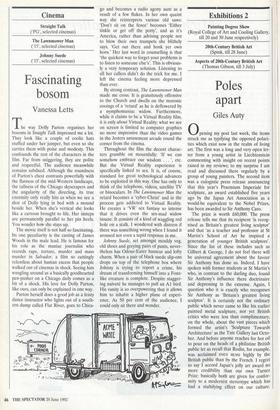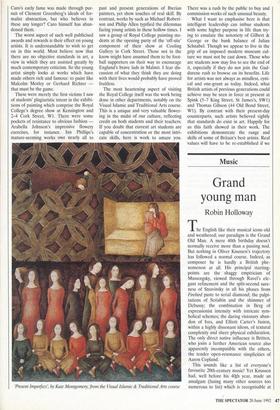Exhibitions 2
Painting Degree Show (Royal College of Art and Cooling Gallery, till 20 and 30 June respectively)
Poles apart
Giles Auty Opening my post last week, the items struck me as typifying the opposed polari- ties which exist now in the realm of living art. The first was a long and very open let- ter from a young artist in Liechtenstein commenting with insight on recent points raised in my reviews; to my surprise I am read and discussed there regularly by a group of young painters. The second item was a eulogistic press release announcing that this year's Praemium Imperiale for sculpture, an award established five years ago by the Japan Art Association as a would-be equivalent to the Nobel Prizes, has been awarded to Sir Anthony Caro.
The prize is worth /60,000. The press release tells me that its recipient `is recog- nised as Britain's greatest living sculptor' and that `as a teacher and professor at St Martin's School of Art he inspired a generation of younger British sculptors'. Since the list of these includes such as Gilbert & George, I do not feel there will be universal agreement about the favour Sir Anthony has done us. Indeed, I have spoken with former students at St Martin's who, in contrast to the darling duo, found Sir Anthony's influence there doctrinaire and depressing in the extreme. Again, I question who it is exactly who recognises Sir Anthony as `Britain's greatest living sculptor'. It is certainly not the ordinary public which never came to like his earlier painted metal sculpture, nor yet British critics who were less than complimentary, on the whole, about the vast pieces which formed the artist's 'Sculpture Towards Architecture' as the Tate Gallery last Octo- ber. And before anyone reaches for hot oil to pour on the heads of a philistine British public let us recall that Rodin, for example, was acclaimed even more highly by the British public than by the French. I regret to say I accord Japan's jolly art award no more credibility than our own Turner Prize: basically both are given for confor- mity to a modernist stereotype which has had a stultifying effect on our culture. Caro's early fame was made through pur- suit of Clement Greenberg's ideals of for- malist abstraction, but who believes in these any longer? Caro himself has aban- doned them.
The worst aspect of such well publicised awards and rewards is their effect on young artists. It is understandable to wish to get on in this world. Most believe now that there are no objective standards in art, a view in which they are assisted greatly by much contemporary criticism. So the young artist simply looks at works which have made others rich and famous: to paint like Malcolm Morley or Gerhard Richter — that must be the game.
These were merely the first victims I saw of students' plagiaristic intent in the exhibi- tions of painting which comprise the Royal College's degree show at Kensington and 2-4 Cork Street, Wl. There were some pockets of resistance to obvious fashion — Arabella Johnson's impressive flowery exercises, for instance. Ian Phillips's mature-seeming works owe nearly all to past and present generations of Iberian painters, yet show touches of real skill. By contrast, works by such as Michael Robert- son and Philip Allen typified the dilemmas facing young artists in these hollow times. I saw a group of Royal College painting stu- dents at the opening party of the 'off-site' component of their show at Cooling Gallery in Cork Street. Those not in the know might have assumed them to be foot- ball supporters on their way to encourage England's brave lads in Maim& I fear dis- cussion of what they think they are doing with their lives would probably have proved fruitless.
The most heartening aspect of visiting the Royal College itself was the work being done in other departments, notably on the Visual Islamic and Traditional Arts course. This is a unique and very valuable flower- ing in the midst of our culture, reflecting credit on both students and their teachers. If you doubt that current art students are capable of concentration or the most intri- cate skills, here is work to amaze you.
'Present Imperfect', by Kate Montgomery, from the Visual Islamic & Traditional Arts course There was a rush by the public to buy and commission works of such unusual beauty.
What I want to emphasise here is that intelligent leadership can imbue students with some higher purpose in life than try- ing to emulate the notoriety of Gilbert & George or the bank balance of Julian Schnabel. Though we appear to live in the grip of an imposed modern museum cul- ture we must not be cast down. Those who are students now may live to see the end of it, especially if they do not join the Gad- darene rush to browse on its benefits. Life for artists was not always as mindless, cyni- cal and one-grunt as today. Indeed, what British artists of previous generations could achieve may be seen in force at present at Spink (5-7 King Street, St James's, SW1) and Thomas Gibson (44 Old Bond Street, W1). By contrast with their present-day counterparts, such artists believed rightly that standards do exist in art. Happily for us this faith showed in their work. The exhibitions demonstrate the range and skills of some of Britain's best artists. Real values will have to be re-established if we



























































 Previous page
Previous page